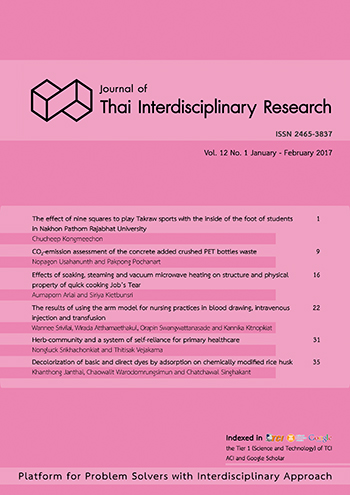The results of using the arm model for nursing practices in blood drawing, intravenous injection and transfusion
Main Article Content
Abstract
The purposes of this research were to 1) develop the arm model for nursing practices in blood drawing, intravenous injection and transfusion to reach the Efficiency of process (E1) and Efficiency of product to be equal to 80 and 80, respectively (E1/E2 = 80/80), 2) compare performance achievement of aforementioned nursing practices between two groups of the students who studied the three nursing skills using the model which was constructed by the researcher and also with another one purchased from abroad and 3) compare the students, satisfaction towards these models. The 60 subjects recruited by selective matching, were the second year nursing students of Boromrajajonani College of Nursing, Ratchaburi who registered in the subject of Principles and Techniques in Nursing in the first semester, the academic year, 2016. The research instruments are consisted of 1) the arm model for nursing practices in blood drawing, intravenous injection and transfusion, 2) the performance assessment form of blood drawing, intravenous injection and transfusion and 3) the questionnaire of the satisfaction of the students towards the model uses. The constructed model was tried out with the students who were not the study subjects to develop the efficiency towards identified standard criteria. The experimental group studied with the model constructed by the researcher, whereas the control group studied with another one purchased from abroad. The data was then analyzed to find percentage, mean, standard deviation and t-test.
The research findings revealed that 1) the efficiency level of the model constructed by the researcher was higher than identified standard criteria (E1/E2 = 92.61/96.95), 2) the average score on performance achievement of the experimental group was statistically significantly higher than that of the control group at 0.001 level and 3) the average score on satisfaction of the experimental group was statistically significantly higher than that of the control group at 0.001 level. These findings concluded that the constructed model can be used effectively as a media in nursing practice, it helps decrease cost for purchasing import model. However, the model should be developed to reach more efficiency such as producing the instruments to fix an arm model during practice, creating more vessels that were designed in various shapes and sizes both obvious and unobvious seen or selecting other materials for cost reduction.
Article Details
References
Office of the National Education Commission. National Education Act, (1999). Bangkok: Office of the
Prime Minister, Kingdom of Thailand; 1999.
Office of the Higher Education Commission. Thai Qualifications Frameworks for Higher
Education of Nursing. Bangkok; 2009.
Praborommarajchanok Institute, Ministry of Public Health. Nursing curriculum (revised version
. n.p. ; 2009.
Wiboonchutikul S.,et al. Significant intolerability of efavirenz in HIV occupational post exposure
prophylaxis. Journal of Hospital Infection. 2016;92:372-377.
Nanthapan B. A construction of natural rubber model of cow's reproductive system with
electronic circuit for artificial insemination training for animal. (Master’s thesis).
Kasetsart University, Bangkok; 2011.
Supanakul P. An analysis of public health research with SPSS program ; theory to practice.
Pitsanuloke:Trakoonthai Publishing; 2014.
Saiyos L, Saiyos A. Technique of educational research. Bangkok: Suveeriyasarn Publishing; 1995.
Promwongs C.,et al. Learning handout for primary school student. Bangkok :Sukhothai Thammatirat
University; 1991.
Yamkasikorn M. How to use efficiency criterion in media research and development: The Difference
between 90/90 Standard and E1/E2. Journal of Education .2007-2008;19 (1): 1-16.
Rattanaviboonsuk N. The result of model use in blood drawing for first year pathology student,
Kanchanapisek Institute of Medical and Public health technology. (Master’s thesis). Kasetsart University, Bangkok; 2012.


